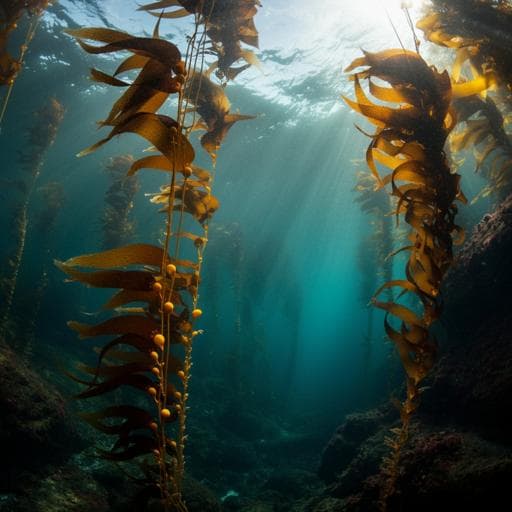
Earth Sciences
Large-scale shift in the structure of a kelp forest ecosystem co-occurs with an epizootic and marine heatwave
M. L. Mcpherson, D. J. I. Finger, et al.
Discover how climate change is reshaping marine ecosystems! This groundbreaking research, conducted by Meredith L. McPherson and colleagues, reveals the alarming decline of bull kelp forests in northern California, driven by extreme marine heatwaves and keystone predator declines. Explore vital ecosystem management strategies to restore these vital underwater habitats.
~3 min • Beginner • English
Introduction
The study investigates how climate-driven marine heatwaves (MHWs) and concurrent biological changes affect bull kelp (Nereocystis luetkeana) forests in northern California. It addresses the challenge of distinguishing gradual climate change from episodic events against natural variability (e.g., ENSO), focusing on the 2014–2016 Northeast (NE) Pacific MHW and a preceding epizootic (sea star wasting syndrome, SSWS) that decimated a key predator, the sunflower star (Pycnopodia helianthoides). The authors aim to determine whether the abrupt ecosystem shift from kelp forest to sea urchin barrens was driven by bottom-up (temperature, nutrients) and/or top-down (predator loss, grazer dynamics) processes, and whether historical kelp forests were resilient to environmental fluctuations. Leveraging a 34-year satellite time series and in situ biological data, the study evaluates the relative contributions of environmental forcings and grazer (urchin) dynamics to changes in kelp canopy coverage and ecosystem state.
Literature Review
The paper situates the work within global evidence that MHWs are increasing in frequency, duration, and intensity, and can restructure coastal ecosystems, including seagrass beds, coral reefs, and kelp forests. Prior studies document widespread kelp declines across multiple regions (Western Australia, Tasman Sea, New Zealand, Baja California, Nova Scotia, northern California) and show that MHWs can shift kelp forests to algal turfs or urchin barrens, often mediated by both bottom-up (warming, nutrient depletion) and top-down (predator control of grazers) processes. The authors note differences among kelp taxa, with giant kelp (Macrocystis pyrifera) showing variable resistance/resilience across Southern and Baja California during the same NE Pacific MHW, contrasting with the annual life history and sensitivity of bull kelp. Literature on alternative stable states and hysteresis in kelp systems (urchin barrens) is cited, as are studies highlighting the role of predator diversity (e.g., sea otters, sunflower stars, sheephead) in maintaining resilience via size-dependent and complementary predation. Historical predator extirpations (sea otters) and disease-driven collapses (SSWS in sunflower stars) are discussed as drivers reducing system resilience and predisposing ecosystems to regime shifts, with additional context on urchin recruitment linked to large-scale climate variability.
Methodology
- Kelp canopy mapping: Used 1985–2019 USGS Landsat 5, 7, and 8 imagery during peak canopy season (August–early November). Applied Multiple Endmember Spectral Mixture Analysis (MESMA) to detect surface bull kelp canopy, leveraging strong near-infrared reflectance. Annual maximum canopy coverage was derived. Error estimates were compared to California Department of Fish and Wildlife (CDFW) aerial surveys using normalized root mean square error (NRMSE).
- Environmental drivers: Considered large-scale climate indices (MEI, PDO, NPGO) and local-scale forcings (sea surface temperature, SST; surface nitrate, NO3; significant wave height, Hs). Hourly/daily datasets (Hs, SST, NO3) were aggregated to monthly means (1985–2019), deseasonalized by removing monthly climatologies, then standardized (mean=0, SD=1). Seasonal (spring, summer) SST and NO3 were computed by averaging standardized monthly values. Marine heatwave (MHW) days per year were derived from daily satellite SST using Hobday et al. (2016). Surface NO3 was estimated from regional SST–NO3 relationships (García-Reyes et al.).
- Biological drivers: Annual densities of purple sea urchin (Strongylocentrotus purpuratus) and sunflower star (Pycnopodia helianthoides) were compiled from CDFW (2003–2018) and Reef Check California (2007–2018) subtidal surveys across Sonoma and Mendocino counties. Survey designs included stratified transects across depth ranges with standardized 60 m² belt transects. Regional annual means were computed and standardized by removing annual climatologies and normalizing by SD.
- Statistical modeling: Partial Least Squares Regression (PLSR) related standardized predictors to annual kelp canopy coverage. PLSR was implemented in Python (sklearn.cross_decomposition PLSRegression) with k-fold cross-validation. For environmental-only models (1985–2016), a one-component, nine-variable configuration was selected. For combined environmental+biological models (2003–2016), to facilitate comparison with the environmental-only case, a one-component, ten-variable configuration was used (though cross-validation indicated two components and four variables were optimal). Models were fit on training periods and used to forecast 2017–2019 canopy under observed and climatological environmental conditions to assess recovery potential versus grazer suppression.
- Trend analysis: Ordinary least-squares regression (OLSR) assessed temporal trends pre- and post-MHW for kelp canopy, spring NO3, MHW days, sunflower star density, and purple urchin density. For pre-2014 sunflower stars, a second-degree polynomial fit was used. Regression slopes, r², p-values, and uncertainties are reported in supplementary materials.
Key Findings
- A sharp, region-wide collapse of bull kelp canopy occurred in 2014, coincident with the NE Pacific MHW and preceded by a 2013 SSWS-driven decline of sunflower stars. Kelp canopy remained suppressed through 2019 despite partial environmental normalization.
- Thermal anomalies: 2014–2015 mean SST anomalies were ~2 SD above the long-term mean, with extremes 3–4 SD above; 2012–2013 were anomalously cool and nutrient-replete.
- Range contraction: The meridional range of kelp narrowed; complete disappearance north of Fort Bragg after 2008 and in the southernmost region after 2012, with historically dense areas (e.g., Point Arena) becoming sparse/patchy.
- PLSR performance: Environmental-only model explained 28.3% of variance (1985–2016) and predicted partial kelp recovery by 2017 as SST/NO3 normalized. Adding biological drivers (urchin density) increased explained variance to 51.9% (2003–2016) and correctly predicted persistent low kelp biomass post-MHW, indicating grazer effects overrode favorable environmental conditions. Simulations with environmental conditions set to climatology (2017–2019) still showed high urchin densities disproportionately suppress kelp.
- Predator and grazer trends: Sunflower star densities declined sharply pre-2014 (slope −0.23 m−2 yr−1; p=0.01) and remained near zero 2013–2018. Purple urchin densities increased markedly (slope 3.1 ± 0.67 m−2 yr−1; p=0.02), with sustained high mean densities (14.8 ± 8.3 m−2) and behavioral shifts to active foraging consistent with barren persistence.
- Historical resilience: Despite sensitivity to the 1997/1998 El Niño (increased MHW days), northern California kelp historically did not undergo widespread collapse, indicating previous resilience to environmental fluctuations. The 2014–2016 sequence of predator loss, extreme warming, nutrient depletion, and urchin recruitment precipitated a persistent alternative state.
- Management implications: The study recommends ecosystem-based, adaptive strategies: (1) monitoring kelp canopy, urchin and predator densities; (2) threshold-based management responses; (3) quantitative restoration suitability indices. Natural urchin mortality agents (disease, large swell) or human interventions may be required for recovery.
Discussion
Findings demonstrate that a coupled top-down and bottom-up disturbance sequence precipitated and maintains a regional phase shift from kelp forest to urchin barren in northern California. The abrupt loss of the keystone predator (sunflower star) reduced top-down control, while the NE Pacific MHW imposed temperature and nutrient conditions exceeding bull kelp physiological thresholds. Concurrently, strong urchin recruitment and behaviorally mediated foraging increases sustained high grazing pressure. Environmental-only models predicted partial kelp recovery with post-2016 improvements in SST and NO3, but incorporating urchin dynamics showed continued suppression of kelp biomass, evidencing hysteresis and positive feedbacks characteristic of alternative stable states. The annual life history of bull kelp, low propagule pressure in sparse conditions, reduced prey quality in barrens (low gonad indices), and diminished predator diversity collectively reduce resilience and impede recovery. While reintroduction or recovery of top predators (e.g., sea otters) can catalyze reversals elsewhere, the current barren state and regional predator extirpation/local extinction complicate recovery trajectories. Long-term, integrated monitoring and forecasting are essential to detect thresholds, guide restoration, and assess when environmental or biological conditions impede or enable recovery.
Conclusion
This study provides a multi-decadal, integrative analysis showing that the 2014–2016 NE Pacific MHW, preceded by SSWS-driven predator collapse, triggered a persistent, low-productivity urchin barren state across 350 km of northern California coastline. Historically resilient bull kelp forests failed to recover despite environmental conditions improving, due to sustained high urchin densities and loss of top-down control. By combining satellite-derived canopy mapping with environmental and biological time series and PLSR modeling, the authors demonstrate that grazer dynamics are essential to explain post-MHW outcomes. The work underscores the need for ecosystem-based, adaptive management, including targeted monitoring, threshold-based responses, restoration suitability assessments, and potentially active urchin reduction or predator restoration. Future research should refine localized urchin population dynamics and recruitment-environment linkages, develop and apply environmental-biological forecasting tools, and expand long-term in situ datasets to better detect, predict, and manage phase shifts.
Limitations
- Limited historical biological data: Reliable in situ sea urchin density data are unavailable prior to 2003; broader community-level data are scarce before 2000, constraining hypothesis testing about pre-MHW biological states and resilience.
- Inference of alternative stable state: While patterns are consistent with an urchin barren alternative stable state and hysteresis, definitive proof of alternative stability is not provided.
- Proxy estimates and remote sensing constraints: Surface NO3 was inferred from SST–NO3 relationships, introducing model uncertainty; satellite methods observe surface canopy only and may not capture subsurface dynamics or early life stages.
- Model structure choices: PLSR configurations balance comparability and cross-validated optimality; results may be sensitive to predictor selection, component number, and standardization choices.
- Spatial generalization: Regional averaging may mask localized variability in environmental forcing, habitat (substrate), and biological interactions; predator and grazer dynamics can be site-specific.
Related Publications
Explore these studies to deepen your understanding of the subject.







